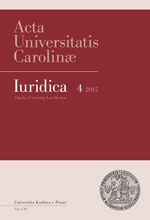Status menšinových jazyků v německém právu – právo na topografická označení a na užívání jazyka ve veřejné sféře
Status of Minority Languages in German Law – The Right to Topographical Indications and to the Use of Language in the Public Sphere
Author(s): Martina FraňkováSubject(s): Law, Constitution, Jurisprudence
Published by: Univerzita Karlova v Praze, Nakladatelství Karolinum
Keywords: Federal Republic of Germany; Danish; Frisian; Lusatian Sorbian; Roma and Sinti; topographical indications; minority languages in the public sphere
Summary/Abstract: The study concerns itself with the status of minority languages in the Federal Republic of Germany with the focus on the right to topographical indications and the use of language in the public sphere, i.e. the contact of a citizen with courts, public authorities and bodies of local governments. The study works on the obligations undertaken by the Federal Republic of Germany in the European Council on the basis of the Framework Convention for the Protection of National Minorities and the Charter of Minority Languages at the end of the 1990s. Considering the theoretical basis of German law, both instruments have the character of federal laws; however, the implementation of particular obligations is vested in individual states. The study deals with the status of the Danish, Frisian, Romany and Sorbian languages, i.e. languages of so-called traditional minorities. A brief introduction to individual minorities and their languages is followed by a summary of their regulation at the constitutional and under-constitutional level, namely the regulation of Danish minority and the Danish language in Schleswig-Holstein, of the Frisians and the Northern and Sater Frisian language in Schleswig-Holstein and Lower Saxony, and of Lusatian Sorbs and Lower and Upper Sorbian in Brandenburg and Saxony. When asserting their rights to the communication with public authorities and bodies of local governments in their minority language and to topographical indications, the minorities are confronted with the ignorance of the regulation of said rights or with the inadequate language training of officers. Also, the particular regulation of rights at the level of individual states might lead to a different standard of protection even within the framework of one and the same language. The situation is different in the case of Roma and Sinti and of the Romany language as, unlike the aforementioned minorities, they are scattered throughout a larger number of constituent states; the Romany language is not codified in the Federal Republic of Germany; the main emphases are put rather on rights connected with education and the social sphere, as well as on the prohibition of discrimination in general. The main benefit of said conventions is, apart from increasing the standard of legal protection of the above stated minorities, the reinforcement of their status with respect to public authorities and bodies of selfgovernments, as well as the opening of a public debate on the issue of rights of minorities in general.
Journal: Acta Universitatis Carolinae Iuridica
- Issue Year: 61/2015
- Issue No: 4
- Page Range: 73-85
- Page Count: 13
- Language: Czech

